


In the exhibition Southbound: Photographs of and about the New South, Daniel Beltrá’s Oil Spill photographs contextualize the complex nature of the American South with natural resources. America’s agricultural community has been one of its greatest assets and one that is historically rooted in society’s traditional Southern lifestyle today. However, along with advances in technology in urban areas, the South has also seen the effects of America’s Industrial Revolution with its booming oil industry. At its peak, a rapid search for oil along with the gold rush redefined the South’s relationship between man and nature through translating America’s natural resources into the culture of mass production.
While modern technological improvements have decreased manual labor, increased efficiency, and benefited America’s economy, these changes in production came with costs to the environment. The images displayed are an excellent example of the value and destruction that comes from human interference with nature. Specifically, the BP oil spill depicted in the photograph has been one of the largest environmental catastrophes of our time and one that our gulf coasts are still recovering from. I especially love Beltrá’s photographs because the vibrant colors at face value create a stunning contrast in the water that almost makes the viewer forget their dark reality, as industrialism often does. The natural beauty of the unnatural phenomenon captured in these photographs to me depicts the dichotomous relationship the American South has with nature, in a way I would have never thought to be possible.
By Stephanie Tanzi, Halsey Institute intern
Image: Daniel Beltrá, Oil Spill #12, 2010, 2010. Gulf of Mexico. From the Spill series